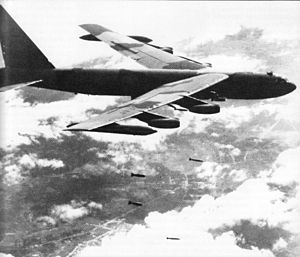
Back غارات ديسمبر Arabic Аперацыя «Паўабаронца II» Byelorussian Операция Лайнбейкър II Bulgarian Operació Linebacker II Catalan Operation Linebacker II German Operación Linebacker II Spanish Operaatio Linebacker II Finnish Opération Linebacker II French Oibríocht Linebacker II Irish Operazione Linebacker II Italian
You can help expand this article with text translated from the corresponding article in Vietnamese. (April 2023) Click [show] for important translation instructions.
|
| Operation Linebacker II | |||||||
|---|---|---|---|---|---|---|---|
| Part of the Vietnam War | |||||||
 Boeing B-52 Stratofortress on bomb run | |||||||
| |||||||
| Belligerents | |||||||
| Commanders and leaders | |||||||
|
John W. Vogt Jr.[6] John C. Meyer[7] Damon W. Cooper[8] |
Lieutenant General Văn Tiến Dũng, Chief of General Staff Major General Phùng Thế Tài,[citation needed] Deputy Chief of General Staff Colonel Lê Văn Tri,[citation needed] Commander of the Air Defense – Air Force | ||||||
| Strength | |||||||
|
197 to 207 strategic bombers B-52,[citation needed] 14 tactical air groups consisting of 1,077 aircraft of all types from 3 air bases and 6 aircraft carrier[9] |
14 SA-2 batteries[10] (266 SA-2 missiles were launched during the operation[10]) 100+ aircraft[7] (including 31 MiG-21s and 16 MiG-17s fighters[11]) AA gun units | ||||||
| Casualties and losses | |||||||
|
U.S. claim:[12] 49 taken prisoner[13] PAVN claim: 81 aircraft shot down (including 34 B-52s and 5 F-111s;[14] this includes two B-52s shot down by MiG-21 fighters[15]) |
U.S. claim: 6 MiG-21s shot down (including 2 MiG-21s shot down by B-52 tail gunners)[7] PAVN claim: 3 MiG-21s shot down[16] 1,624 civilians killed[17] | ||||||
Operation Linebacker II, sometimes referred to as the Christmas bombings and, in Vietnam, Dien Bien Phu in the air,[a] was a strategic bombing campaign conducted by the United States against targets in North Vietnam from 18 December to 29 December 1972, during the Vietnam War. More than 20,000 tons of ordnance was dropped on military and industrial areas in Hanoi and Haiphong and at least 1,624 civilians were killed. The operation was the final major military operation carried out by the U.S. during the conflict, and the largest bombing campaign involving heavy bombers since World War II.
By late 1972, U.S. combat involvement in Vietnam had been dramatically reduced, and negotiations to end the war were underway in Paris. After secret meetings in October between lead negotiators Henry Kissinger and Le Duc Tho, an informal agreement was reached. The terms included a total U.S. withdrawal, North Vietnam's recognition of South Vietnam, new borders based on the present front lines, and new elections in the South, which would include the then-banned Communist Party of Vietnam. South Vietnamese president Nguyen Van Thieu, however, totally rejected these terms when he was informed about them and, following Richard Nixon's reelection in November, the U.S. submitted new terms, which included the Vietnamese Demilitarized Zone (DMZ) as the recognized national border, leading to a breakdown in negotiations on 16 December. Nixon issued an ultimatum for the North to return to negotiations within 72 hours, after which he ordered the bombing campaign on 18 December. Conducted by more than 200 B-52 bombers from Strategic Air Command supported by tactical planes of the Seventh Air Force and Task Force 77, the raids ran from 18 to 24 December and 26 to 29. The U.S. acknowledged the loss of 16 B-52 bombers, while North Vietnam claimed 34 bombers shot down.
The effect of the bombings on the peace negotiations is debated. On 22 December, Nixon asked the North to return to the talks with the terms offered in October and warned Thieu that he would sign the agreement even if Thieu did not. The North agreed, and Nixon ordered a halt to the bombings on 30 December. The North Vietnamese delegation stated that the campaign played no role in the decision to return to negotiations, while an aide to Kissinger remarked that "[w]e bombed the North Vietnamese into accepting our concessions". On 27 January 1973, the Paris Peace Accords were signed along the same terms as the initial October agreement.
- ^ Lương Cường (15 December 2022). "Victory of Ha Noi – Dien Bien Phu in the Air in 1972: Vietnamese spirit and wisdom". National Defence Journal. Central Military Commission of the Communist Party of Vietnam.
- ^ Pribbenow, Merle L. (2001). "Rolling Thunder and Linebacker Campaigns: The North Vietnamese View". The Journal of American-East Asian Relations. 10 (3/4): 197–210. doi:10.1163/187656101793645524. JSTOR 23613043.
- ^ Beagle, T. W. (2001). Operation Linebacker II (Report). Air University Press. pp. 35–50.
- ^ "Operation Linebacker II: The 11-Day War". HistoryNet. 29 December 2020. Retrieved 7 November 2023.
- ^ "How Operation Linebacker II Took the North Vietnamese By Surprise". HistoryNet. 4 January 2023. Retrieved 7 November 2023.
- ^ Thompson, p. 257.
- ^ a b c "Linebacker". Air Force Magazine. November 1997. Retrieved 27 December 2015.
- ^ Thompson, p. 257.
- ^ James R. McCarthy and Robert E. Rayfield. Linebacker II is a view from the rock. pp. 29–34
- ^ a b Drenkowski & Grau 2007, p. 22
- ^ Drenkowski & Grau 2007, p. 26
- ^ B-52_Stratofortress Archived 14 February 2010 at the Wayback Machine, Project Get Out and Walk
- ^ Dorr & Peacock 2000, p. 180.
- ^ Pribbenow, p. 327.
- ^ Cite error: The named reference
Thompsonwas invoked but never defined (see the help page). - ^ "Nga nói gì về cuộc đấu MiG-21 và F-4 ở Việt Nam (2)". Kien thuc. 27 December 2013. Retrieved 27 December 2015.
- ^ Morocco 1985, p. 150.
Cite error: There are <ref group=lower-alpha> tags or {{efn}} templates on this page, but the references will not show without a {{reflist|group=lower-alpha}} template or {{notelist}} template (see the help page).